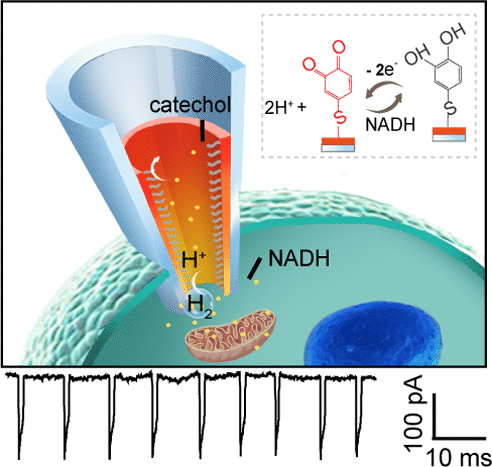当前位置:
X-MOL 学术
›
J. Am. Chem. Soc.
›
论文详情
Our official English website, www.x-mol.net, welcomes your feedback! (Note: you will need to create a separate account there.)
Asymmetric Nanopore Electrode Based Amplification for Electron Transfer Imaging in Live Cells
Journal of the American Chemical Society ( IF 15.0 ) Pub Date : 2018-03-12 , DOI: 10.1021/jacs.7b12106 Yi-Lun Ying 1 , Yong-Xu Hu 1 , Rui Gao 1 , Ru-Jia Yu 1 , Zhen Gu 1 , Luke P. Lee 2, 3 , Yi-Tao Long 1
Journal of the American Chemical Society ( IF 15.0 ) Pub Date : 2018-03-12 , DOI: 10.1021/jacs.7b12106 Yi-Lun Ying 1 , Yong-Xu Hu 1 , Rui Gao 1 , Ru-Jia Yu 1 , Zhen Gu 1 , Luke P. Lee 2, 3 , Yi-Tao Long 1
Affiliation

|
Capturing real-time electron transfer, enzyme activity, molecular dynamics, and biochemical messengers in living cells is essential for understanding the signaling pathways and cellular communications. However, there is no generalizable method for characterizing a broad range of redox-active species in a single living cell at the resolution of cellular compartments. Although nanoelectrodes have been applied in the intracellular detection of redox-active species, the fabrication of nanoelectrodes to maximize the signal-to-noise ratio of the probe remains challenging because of the stringent requirements of 3D fabrication. Here, we report an asymmetric nanopore electrode-based amplification mechanism for the real-time monitoring of NADH in a living cell. We used a two-step 3D fabrication process to develop a modified asymmetric nanopore electrode with a diameter down to 90 nm, which allowed for the detection of redox metabolism in living cells. Taking advantage of the asymmetric geometry, the above 90% potential drop at the two terminals of the nanopore electrode converts the faradaic current response into an easily distinguishable bubble-induced transient ionic current pattern. Therefore, the current signal was amplified by at least 3 orders of magnitude, which was dynamically linked to the presence of trace redox-active species. Compared to traditional wire electrodes, this wireless asymmetric nanopore electrode exhibits a high signal-to-noise ratio by increasing the current resolution from nanoamperes to picoamperes. The asymmetric nanopore electrode achieves the highly sensitive and selective probing of NADH concentrations as low as 1 pM. Moreover, it enables the real-time nanopore monitoring of the respiration chain (i.e., NADH) in a living cell and the evaluation of the effects of anticancer drugs in an MCF-7 cell. We believe that this integrated wireless asymmetric nanopore electrode provides promising building blocks for the future imaging of electron transfer dynamics in live cells.
中文翻译:

基于不对称纳米孔电极的活细胞电子转移成像放大
捕获活细胞中的实时电子转移、酶活性、分子动力学和生化信使对于理解信号通路和细胞通讯至关重要。然而,没有通用的方法可以在细胞室的分辨率下表征单个活细胞中广泛的氧化还原活性物种。尽管纳米电极已应用于氧化还原活性物质的细胞内检测,但由于 3D 制造的严格要求,制造纳米电极以最大化探针的信噪比仍然具有挑战性。在这里,我们报告了一种基于不对称纳米孔电极的放大机制,用于实时监测活细胞中的 NADH。我们使用两步 3D 制造工艺开发了直径低至 90 nm 的改良不对称纳米孔电极,可用于检测活细胞中的氧化还原代谢。利用不对称几何形状,纳米孔电极两端超过 90% 的电位降将法拉第电流响应转换为易于区分的气泡诱导瞬态离子电流模式。因此,电流信号被放大了至少 3 个数量级,这与痕量氧化还原活性物质的存在动态相关。与传统的线电极相比,这种无线非对称纳米孔电极通过将电流分辨率从纳安提高到皮安而表现出高信噪比。不对称纳米孔电极实现了对低至 1 pM 的 NADH 浓度的高灵敏度和选择性探测。此外,它还可以对活细胞中的呼吸链(即 NADH)进行实时纳米孔监测,并评估抗癌药物在 MCF-7 细胞中的作用。我们相信,这种集成的无线非对称纳米孔电极为活细胞中电子转移动力学的未来成像提供了有前景的构建模块。
更新日期:2018-03-12
中文翻译:

基于不对称纳米孔电极的活细胞电子转移成像放大
捕获活细胞中的实时电子转移、酶活性、分子动力学和生化信使对于理解信号通路和细胞通讯至关重要。然而,没有通用的方法可以在细胞室的分辨率下表征单个活细胞中广泛的氧化还原活性物种。尽管纳米电极已应用于氧化还原活性物质的细胞内检测,但由于 3D 制造的严格要求,制造纳米电极以最大化探针的信噪比仍然具有挑战性。在这里,我们报告了一种基于不对称纳米孔电极的放大机制,用于实时监测活细胞中的 NADH。我们使用两步 3D 制造工艺开发了直径低至 90 nm 的改良不对称纳米孔电极,可用于检测活细胞中的氧化还原代谢。利用不对称几何形状,纳米孔电极两端超过 90% 的电位降将法拉第电流响应转换为易于区分的气泡诱导瞬态离子电流模式。因此,电流信号被放大了至少 3 个数量级,这与痕量氧化还原活性物质的存在动态相关。与传统的线电极相比,这种无线非对称纳米孔电极通过将电流分辨率从纳安提高到皮安而表现出高信噪比。不对称纳米孔电极实现了对低至 1 pM 的 NADH 浓度的高灵敏度和选择性探测。此外,它还可以对活细胞中的呼吸链(即 NADH)进行实时纳米孔监测,并评估抗癌药物在 MCF-7 细胞中的作用。我们相信,这种集成的无线非对称纳米孔电极为活细胞中电子转移动力学的未来成像提供了有前景的构建模块。



























 京公网安备 11010802027423号
京公网安备 11010802027423号